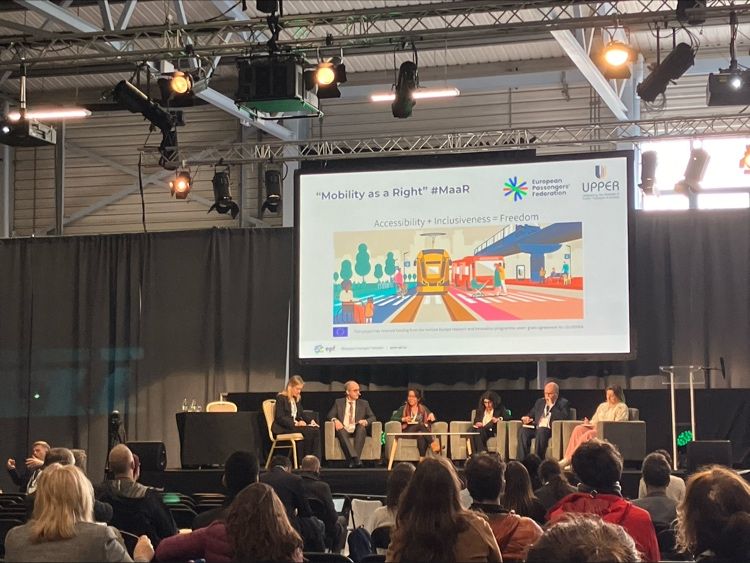EPF was at TRA – Transport Research Arena – in Dublin last month, participating as a panelist in a Strategic Session on People Centred & Inclusive Mobility. During the session, Delphine Grandsart from EPF highlighted the need to involve end-users – including vulnerable to exclusion groups – in the development of mobility services in order to have a public transport system that is accessible and inclusive – one of EPF’s core objectives. She also talked about the “Mobility as a Right” concept, how it has been applied in Oslo and how it has become one of the pillars of the Horizon project UPPER.
The Transport Research Arena (TRA) is Europe’s biggest transport event, covering all transport modes and all aspects of mobility. In 2024, TRA took place in Dublin, Ireland. This year’s theme was “Transport Transitions: Advancing Sustainable and Inclusive Mobility”. EPF was invited as a speaker at TRA in Strategic Session 1.3 – People Centred & Inclusive Mobility on Monday, 15. April, together with Françoise Guaspare (Ile-de-France), Torsten Klimke (DG MOVE), Brendan O’Brien (Dublin City Council) and Lindsey Mancini (UITP). The session was moderated by Ingrid Skogsmo (ECTRI).
The panel addressed the need for more people-centred and inclusive mobility, seeking to clarify these terms and inspiring attendees with successful examples showcasing the improvement of inclusiveness and people-centricity in mobility and the effects of such initiatives. During the session, Delphine Grandsart from EPF highlighted the need to involve end-users – including vulnerable to exclusion groups – in the development of mobility services in order to have a public transport system that is accessible and inclusive – one of EPF’s core objectives. She also talked about the “Mobility as a Right” concept, how it has been applied in Oslo and how this approach has inspired the Horizon project UPPER to make #MaaR one of its pillars.
UPPER aims to strengthen the role of public transport as the cornerstone of sustainable urban mobility. The project will implement a combination of measures looking to push people out of private cars and to pull them closer to public transport in 10 cities across Europe. Oslo is one of those cities, and has been working on building a culture of social inclusion to make sure their public transport services are for everyone.
“Mobility as a Right” (#MaaR) is a strategic vision to ensure inclusive mobility whereby all citizens are taken into consideration, regardless of their physical and mental capabilities or social and economic background – a vision that is very inspiring, and that UPPER is now actively promoting through a series of dissemination events, in order for other cities and regions to follow Oslo’s example.
From EPF’s perspective, to achieve an inclusive and accessible mobility offer, it is key to: put the end-users first; involve them in all phases of the development; reach out to vulnerable to exclusion groups; and apply Universal Design principles. Now this is exactly what Ruter did in Oslo – which is why Delphine chose to highlight the Oslo approach as a best practice in her presentation. Some key takeaways:
- Fundamental change: In 2020, Bernt Reitan Jenssen, CEO of Ruter, met a young man who left a great impression on him. In a debate on Norwegian television, Amir Hashani stated that as a wheelchair user, he often had to give up on traveling by bus because the bus ramp had got stuck or because the ramp key was missing. Increased freedom of movement for the disabled became one of Ruter’s most important strategic priorities and Ruter started to work on their culture, awareness and internal processes – as well as technology and physical solutions.
- Good for everyone: While persons with reduced mobility and persons with disabilities already make up a large group by themselves (around 18% of the population, according to Bufdir) – measures to improve accessibility for them will also benefit many more passengers. For example, step-free access is a necessity for wheelchair users but also makes life on public transport a lot easier for e.g., tourists carrying luggage, families with small children, elderly people, etc. This is exactly the philosophy behind the Universal Design or Design for All approach.
- Insight into obstacles: To identify the obstacles that disabled people encounter on Ruter’s public transport services, Ruter started a close collaboration with the Norwegian Association of the Disabled. In-depth interviews were conducted with interest groups and people with a wide range of disabilities, as well as with drivers and other staff. What came out of this was four main priorities: being able to travel independently; to travel safely; to participate in society (for which transport is an enabler!); and to travel spontaneously.
- Changes start at the top: Since 2021, Ruter worked on raising awareness internally. Managers and middle managers participated in “Mind the Gap” workshops – because change starts at the top. These managers travelled with ‘ability mentors’ from the Norwegian Association of the Disabled and were challenged to travel alone by bus in a wheelchair, making them feel more aware of the obstacles encountered by people with disabilities, and motivating them to improve the situation.
EPF’s slides can be downloaded here. More information on the UPPER project and the #MaaR concept here!




 Stay informed!
Stay informed!